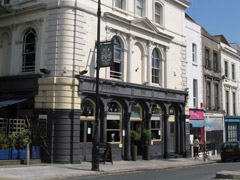


In the 1800s Camden underwent a period of incredible transformation. The development of the railways meant a dramatic increase in noise and pollution; Camden went from being a semi-rural, well-to-do, middle class area to an industrial down-at-heel one. Workers cottages were built in a hurry to accommodate railway employees, usually cheaply made and squalid – yes, slum housing was present in NW1 too. Ironically, some of the former cottages can still be seen in Primrose Hill, now fetching hefty sums due to their postcode, albeit after undergoing years of renovations and extensions.
But back to the 19th century. The railway workers hailed Ireland, Wales, Scotland and England, and had a tendency to spar with one another after having too many drinks in the local pubs of an evening. The solution? To create a pub to accommodate each country, thus limiting the possibilities of confrontation. This reasoning wasn’t just about keeping the peace however, as less nightly fights also meant the men were in a better condition to work the next day. And so Edinboro Castle, Windsor Castle, Pembroke Castle and Dublin Castle were born, dotted around Primrose Hill and Camden, located close to, and in some cases directly above the railway tracks. Thankfully nowadays national segregation is not enforced, and anyone irrespective of origin is allowed to enter the drinking holes as they please. And while there is a uniform of skinny jeans and brogues for the boys and printed baggy pants and top knots for the girls, this isn’t compulsory.
Initially named the Edinburgh Castle, the deliberately misspelt Edinboro Castle just off Parkway, used to house a library, picture gallery and a museum with curious objects that once belonged to Captain Nelson. A large piece of land where lawn billiards were played became part of the beer garden, albeit after giving up several metres for the railway tracks in 1838. A very disappointed customer set fire to the pub in 1984, causing damage so great that it took the pub owners three years to restore it before re-opening. Operator Charringtons stepped up, and the décor was returned to its Victorian splendor. One of the late Amy Winehouse’s favourite locals (we know you’re thinking this phrase is going to get repeated a lot, but bear with us) today it courts the gastropub crowd, offering, as one blogger succinctly put it, “beer battered haddock and skin-on chips” rather than plain old fish and chips.
\n\nThe Dublin Castle is by far the most famous of the castle establishments, and one of Camden’s best known venues. It’s certainly a very different haunt nowadays to when Irish navvies frequented it after a long day’s hard graft. In 1979 an enterprising chap by the name of Alo Conlon bought the pub, having arrived in London from his native Ireland smuggled on a boat in the 50s. Under his management the Dublin Castle developed a reputation for showcasing new music; Madness performed one of their first gigs here, having convinced Conlon they played a mixture of country & western and jazz. A pivotal Britpop venue in the 90s, it hosted Blur and Supergrass at the start of their careers, later it would be the Killers and the Arctic Monkeys when stardom was just a twinkle in their eye. Winehouse was even known to get behind the bar and pull the odd pint here. Conlon passed away in 2009, but the Dublin Castle is still managed by his widow and son, who’ve kept the music policy firmly entrenched in indie rock. With a later closing time than many of the other local establisments, there’s a healthy crowd of both locals and tourists gathered at this legendary pub most nights of the week.
English pub the Windsor Castle was just a few doors down from the Dublin, on Parkway (not to be confused with the pub of the same name on Park Road). The Windsor is no longer around, and nothing seems to last very long in this site – it’s been a pub called the Warwick Castle, a bar called NW1, and it currently houses a branch of the rather average French brasserie chain Côte. \n\nThe Pembroke Castle in affluent Primrose Hill is also situated right above the railways. Originally built to accommodate Welsh workers, today it’s morphed into an upmarket gastropub, with the occasional bargain lunch deal like steak frites for £15. The terrace is a big draw when the sun is out, with the added bonus of heating for smokers to avoid hypothermia in the winter.
A pub that gets mentioned less often is the Caernarvon Castle, originally opened under the name Pickford Arms in 1869, but not to be mixed up with the other, more nationalistic castle pubs. It was located at 7-8 Chalk Farm Road, a site that has also seen various businesses come and go, such as the Fusilier & Firkin, the Camden Rock Café and finally a clothes shop which was destroyed in the fire that temporarily closed the Hawley Arms (at last, another Winehouse favourite!) Now the site forms part of the global street food market that overlooks Camden Lock.
Further reading: Camden Town and its miscreants


